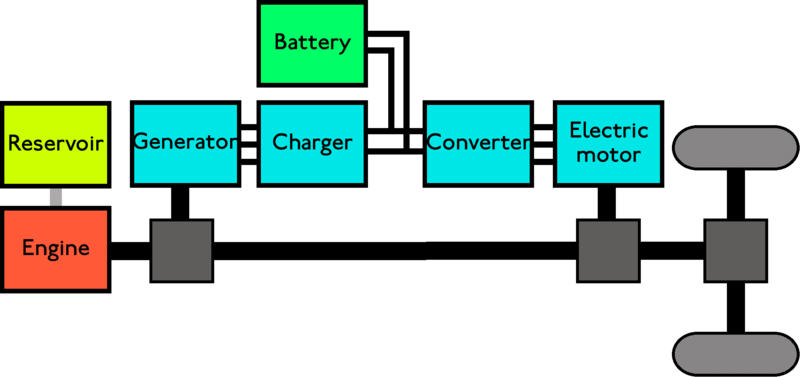By John Donovan, Mouser Electronics
Electric vehicles were all the rage 100 years ago. Quiet and lacking manual cranking, most ran 35 to 50 miles between recharges, but some went 100 miles. Electric vehicles (EVs) are hot again. Analysts at A.T. Kearney predict that by 2020, the global EV market will reach10-15% of vehicle sales. But what happens when you accelerate in an EV? It depends:
- Nissan Leaf, Ford Focus EV, and Tesla Model S run entirely on electricity.
- Hybrid electric vehicles (HEVs) like the Toyota Prius and Chevrolet Volt (a Plug-in HEV) propel themselves via stored electricity and gasoline.
Electric motors exhibit maximum torque at startup, with torque declining linearly as it speeds up. Gas engines only exhibit high torque at high speeds. For snappy pick-up, a combination of the two makes sense.
Two HEV variants are:
- Series hybrids (Volt )
- Power-split or series-parallel hybrids (Prius)
A series hybrid drive train (Figure 1) runs the electric motor until the battery drops below a certain level, at which point the gas engine powers a generator that helps power the car. An accelerating Volt increases the electricity to its traction motor, the sole power source in the first 35 miles.

Figure 1 : Series hybrid drive train.
A series-parallel (or power split) drive train (Figure 2) has an electric motor and gas engine. The Prius starts as an EV, where it stays until 25 mph or one mile, and then transitions to the gas engine.

Figure 2 : Series-parallel drive train.
Texas Instruments' TMS570LS Series MCUs are high-performance automotive microcontrollers for safety critical applications based on the ARM® CortexTM -R4F, include CAN, Flex-Ray, and LIN 2.0, and are certified-SIL3 automotive. Infineon FS75507N2E4 EconoPACKTM 2 IGBT modules include six IGBTs rated at 650VCES and an ICnom /ICRM of 75A/150A. Intended for driving large PM motors, the 150°C-rated modules self-limit short circuits. STMicroelectronics TD350E IGBT/MOSFET drivers rate 1.5A source/2.3A sink, with 2kV ESD protection.
Electric vehicles may not be new, but they have come a long way. EVs need to become lighter, faster, and less expensive, requiring innovative engineering to overcome some complex challenges. Mouser Electronics encourages innovation with a broad selection of automotive electronics on their automotive site.
Advertisement
Learn more about Mouser Electronics





